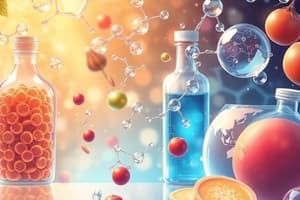Podcast
Questions and Answers
What is one of the primary functions of carbohydrates in humans?
What is one of the primary functions of carbohydrates in humans?
- Serving as the only source of cellular energy
- Providing structural components of cell membranes
- Providing energy through oxidation (correct)
- Synthesis of nucleic acids
Which of the following best describes monosaccharides?
Which of the following best describes monosaccharides?
- Complex carbohydrates consisting of multiple sugar units
- Always contain 8 or more carbon atoms
- Cannot be hydrolyzed into simpler sugars (correct)
- Are commonly found as polysaccharides
What is the general formula for carbohydrates?
What is the general formula for carbohydrates?
- CnH2nOn (correct)
- C(n+1)H2nO2
- C2nH2O2
- C2nH2O
Which of the following examples are disaccharides?
Which of the following examples are disaccharides?
In terms of structure, what is a polysaccharide?
In terms of structure, what is a polysaccharide?
What does chirality refer to in the context of molecules?
What does chirality refer to in the context of molecules?
Which carbohydrate provides a short-term energy reserve in the human body?
Which carbohydrate provides a short-term energy reserve in the human body?
Which type of carbohydrate is defined as containing two monosaccharide units?
Which type of carbohydrate is defined as containing two monosaccharide units?
What is a characteristic of oligosaccharides?
What is a characteristic of oligosaccharides?
What is true about chiral centers?
What is true about chiral centers?
Which of the following defines an achiral molecule?
Which of the following defines an achiral molecule?
How are enantiomers of glyceraldehyde distinguished?
How are enantiomers of glyceraldehyde distinguished?
What are stereoisomers?
What are stereoisomers?
Polysaccharides are characterized by what feature?
Polysaccharides are characterized by what feature?
Which of the following is not a property of a chiral molecule?
Which of the following is not a property of a chiral molecule?
What happens during hydrolysis of oligosaccharides?
What happens during hydrolysis of oligosaccharides?
What is produced when an enzyme oxidizes the primary alcohol end of an aldose?
What is produced when an enzyme oxidizes the primary alcohol end of an aldose?
Which process involves the replacement of a hydroxyl group with an amino group in a monosaccharide?
Which process involves the replacement of a hydroxyl group with an amino group in a monosaccharide?
Which type of reaction results in the formation of alditols from monosaccharides?
Which type of reaction results in the formation of alditols from monosaccharides?
What characterizes lipids compared to other biomolecules?
What characterizes lipids compared to other biomolecules?
Which of the following best describes glycoside formation?
Which of the following best describes glycoside formation?
Which statement is true regarding phosphates and monosaccharides?
Which statement is true regarding phosphates and monosaccharides?
What is a common use of lipids in organisms?
What is a common use of lipids in organisms?
Which of the following is NOT a characteristic of lipids?
Which of the following is NOT a characteristic of lipids?
What characterizes a polyunsaturated fatty acid (PUFA)?
What characterizes a polyunsaturated fatty acid (PUFA)?
What does the IUPAC name '9,12-octadecadienoic acid' indicate?
What does the IUPAC name '9,12-octadecadienoic acid' indicate?
How does the solubility of fatty acids change with increasing carbon chain length?
How does the solubility of fatty acids change with increasing carbon chain length?
What is the significance of the position of the double bonds in unsaturated fatty acids?
What is the significance of the position of the double bonds in unsaturated fatty acids?
Which of the following correctly describes the structure of triacylglycerols?
Which of the following correctly describes the structure of triacylglycerols?
What type of fatty acids are characterized by having hydrogen atoms on opposite sides of the double bond?
What type of fatty acids are characterized by having hydrogen atoms on opposite sides of the double bond?
What does the notation '18:3 (Δ9,12,15)' signify?
What does the notation '18:3 (Δ9,12,15)' signify?
Which characteristic best describes long-chain fatty acids?
Which characteristic best describes long-chain fatty acids?
What factor most significantly influences the melting point of triacylglycerols?
What factor most significantly influences the melting point of triacylglycerols?
Which type of fatty acids tend to be solids at room temperature?
Which type of fatty acids tend to be solids at room temperature?
What happens to the number of 'bends' in a fatty acid chain when the number of double bonds increases?
What happens to the number of 'bends' in a fatty acid chain when the number of double bonds increases?
What type of triacylglycerol is formed from the esterification of glycerol with three identical fatty acid molecules?
What type of triacylglycerol is formed from the esterification of glycerol with three identical fatty acid molecules?
Which type of fatty acid is considered 'good fat' that can help reduce heart disease?
Which type of fatty acid is considered 'good fat' that can help reduce heart disease?
What is the current recommended percentage of total fat intake in calories for Monounsaturated Fatty Acids (MUFA)?
What is the current recommended percentage of total fat intake in calories for Monounsaturated Fatty Acids (MUFA)?
What type of triacylglycerol is formed from the esterification of glycerol with more than one kind of fatty acid molecule?
What type of triacylglycerol is formed from the esterification of glycerol with more than one kind of fatty acid molecule?
Which of the following statements is true about the energy storage properties of triacylglycerols?
Which of the following statements is true about the energy storage properties of triacylglycerols?
Study Notes
Biochemistry
- Study of chemical substances in living organisms and their interactions
- Includes bioinorganic and bioorganic substances
Bioinorganic Substances
- Water (70% of mass)
- Inorganic salts (5% of mass)
Bioorganic Substances
- Proteins (15% of mass)
- Lipids (8% of mass)
- Carbohydrates (2% of mass)
- Nucleic acids (2% of mass)
Carbohydrates
- About 75% of the dry mass of plant material
- Important for energy production, storage, structure, and cell recognition
Carbohydrate Functions
- Oxidation provides energy
- Storage as glycogen provides a short energy reserve
- Supplies carbon atoms for other biomolecules
- Structural component of DNA and RNA
- Structural component of cell membranes
- Linked to protein function in cell-cell and cell-molecule recognition process
Carbohydrate Classification
- General formula: CnH2nOn or Cn(H2O)n
- Polyhydroxy aldehydes or ketones
Monosaccharide
- Single polyhydroxy aldehyde or ketone unit
- Cannot be broken down by hydrolysis
- Common examples: Glucose, fructose
Disaccharide
- Contains two monosaccharide units covalently bonded
- Common examples: Sucrose, lactose
Oligosaccharide
- Contains 3 to 10 monosaccharides
- Usually found associated with proteins and lipids
- Can be broken down into multiple monosaccharides via hydrolysis
Polysaccharide
- Polymeric carbohydrates with many monosaccharides
- Undergo hydrolysis under appropriate conditions
- Common examples: Cellulose and starch
Chirality
- Related to handedness of molecules
- Left-handedness and right-handedness are forms of isomerism
Mirror Images
- Reflection of an object in a mirror
- Superimposable mirror images coincide at all points when laid on top of each other
- Nonsuperimposable mirror images do not coincide at all points when laid on top of each other
Chirality in Molecules
- Presence of a carbon atom with four different groups bonded in a tetrahedral orientation
- Chiral center: carbon atom that generates handedness
- Chiral molecule: mirror images are not superimposable
- Achiral molecule: mirror images are superimposable
Stereoisomers
- Isomers with the same molecular and structural formula but differ in the orientation of atoms in space
- Two types: Enantiomers and diastereomers
Fischer Projection Formula
- Two-dimensional notation showing the spatial arrangement of groups around chiral centers in molecules
D, L System for Handedness
- Glyceraldehyde enantiomers are used as a reference to designate handedness
- Applied to monosaccharides with more than one chiral center in the lower manner
Haworth Projection Formula
- Two-dimensional notation specifying the three-dimensional structure of cyclic forms of monosaccharides
Enzymatic Oxidation Reaction
- Enzymes oxidize the primary alcohol end of an aldose, such as glucose
- Produces alduronic acid
Phosphate Ester Formation
- Hydroxyl groups of monosaccharides react with inorganic oxyacids to form inorganic esters
Reduction Reaction to Produce Sugar Alcohols
- Reduction of a monosaccharide results in a polyhydroxy alcohol
- Polyhydroxy alcohols are called sugar alcohols or alditols
Amino Sugar Formation
- Replacement of a hydroxyl group of a monosaccharide with an amino group
Glycoside Formation
- Hemiacetal reacts with alcohols in acid solution to produce acetals
- Glycoside: acetal form of a cyclic monosaccharide with the hemiacetal carbon –OH group replaced with an -OR group
Lipids
- Organic compounds found in living organisms that are insoluble (or sparingly soluble) in water, but soluble in nonpolar solvents
- Can be esters, amides, and alcohols (acyclic, cyclic, and polycyclic)
- Do not have a common structural feature that defines all lipids
Lipid Characteristics
- Mostly hydrophobic
- Made up of mostly C-H bonds
- Useful for long-term energy storage
- Make up the membranes of cells
Fatty Acids
- Carboxylic acids with a hydrocarbon chain
- Saturated: no double bonds in carbon chain (single bond)
- Unsaturated: one or more double bonds in carbon chain (double bonds)
Polyunsaturated Fatty Acids
- Fatty acids with two or more carbon-carbon double bonds in the carbon chain
Omega (ω)-6 Fatty Acids
- Unsaturated fatty acids with their endmost double bond six carbon atoms away from the methyl end
IUPAC Names for Fatty Acids
- Example: cis,cis-9,12-octadecadienoic acid indicates a double bond at carbons 9 and 12
Trans Unsaturated Fatty Acids
- The H atoms on the double bond are on opposite sides
Physical Properties of Fatty Acids
- Water solubility: directly related to carbon chain length; solubility decreases as chain length increases
- Short-chain fatty acids: slightly soluble
- Long-chain fatty acids: insoluble in water; nonpolar nature dominates solubility
- Melting point: strongly influenced by carbon chain length and degree of unsaturation
- Longer carbon chains have higher melting points
- Saturated fatty acids tend to be solid at room temperature
- Unsaturated fatty acids tend to be liquid at room temperature
Energy Storage Lipids: Triacylglycerols
- Human cells store small amounts of these materials
- Used as an energy source when energy demands are high
Triacylglycerols: Basic Structure
- Dehydration synthesis reaction
- Triacylglycerols are triesters (3 ester functional groups)
- Alcohol: glycerol
- Esterification reaction: one molecule of glycerol reacts with three fatty acids
- Acyl group: portion of a carboxylic acid remaining after the -OH group is removed from the carboxyl carbon atom
Triacylglycerols: Types
- Simple triacylglycerol: all three fatty acids are identical
- Mixed triacylglycerol: more than one kind of fatty acid is present
Types of Fatty Acids:
- Saturated Fatty Acids: Mostly solid at room temperature; commonly found in animal fats (butter, lard)
- Monounsaturated Fatty Acids (MUFA): "Good fats"; decrease heart disease and breast cancer risk; help reduce blood platelet stickiness and prevent blood clots; found in olive, avocado, and canola oils
- Polyunsaturated Fatty Acids (PUFA): "Good fats" and "bad fats"; found in many sources: vegetable oils, nuts, seeds
- Essential Fatty Acids: Required by the body but not produced by the body; include omega-3 and omega-6 fatty acids.
Recommended Fatty Acid Intake
- 15% of total fat intake should be MUFA
- 10% of total fat intake should be PUFA
Studying That Suits You
Use AI to generate personalized quizzes and flashcards to suit your learning preferences.
Related Documents
Description
Explore the essential biochemistry of carbohydrates, including their classification, functions, and significance in living organisms. This quiz covers the structures and roles of monosaccharides and their contributions to energy production, storage, and structural integrity in cells.




